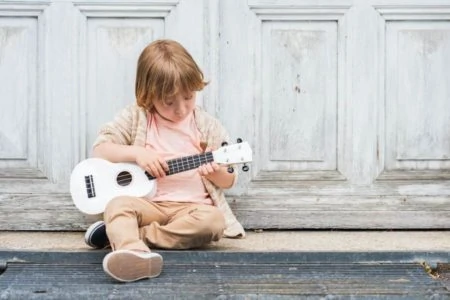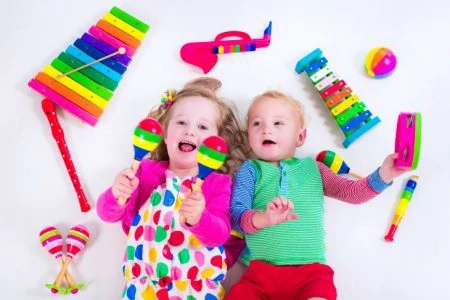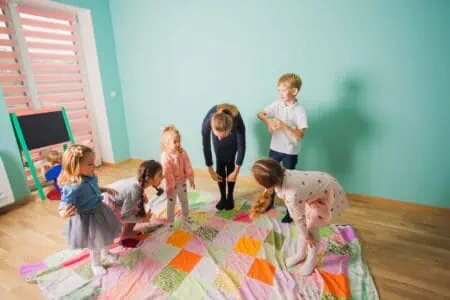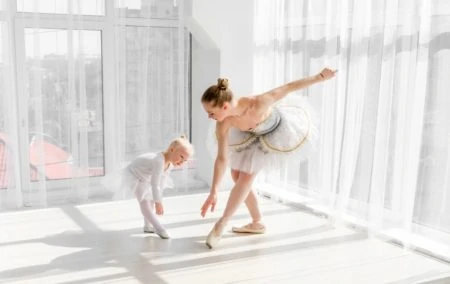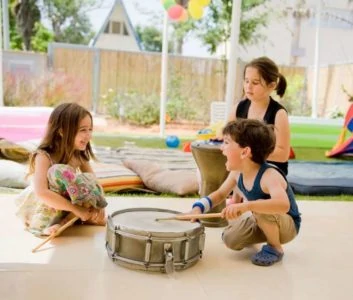Ready to fill your home with music? The ukulele is the perfect gateway instrument for kids. It is small, affordable, and surprisingly easy to learn. But with endless toy options mixed in with real instruments, finding the right one can be tricky.
We ignored the junk and tested the top contenders to find the best ukuleles for kids that actually stay in tune and sound great. Whether you have a toddler who just wants to make noise or a tween ready for serious lessons, we have found the perfect fit for your little musician.
- Beveled armrest for comfort
- Guitar-styled tuner pegs
- Stays in tune
- Good strings and body material
- Excellent acoustic sound
- Comes with extra learning resources
- Aquila strings
- Arched back and fuller sound
- Unconditional lifetime warranty
Ukulele Versus Guitar
When a child shows interest in the guitar, it is smart to introduce them to a ukulele first. It is less intimidating, cheaper, and physically easier for small hands to manage.
While they look similar, the differences are huge for a beginner:
- The strings: Ukuleles use soft nylon strings that are gentle on uncalloused fingertips. Guitars often use steel strings which can hurt beginner hands.
- The complexity: A ukulele has four strings. A guitar has six. Fewer strings mean simpler chords.
- The size: The short neck and small body of a ukulele fit perfectly in a child’s lap.
How to Choose a Ukulele for Kids
Before you click “add to cart,” there are a few specs you need to check to ensure you aren’t buying a glorified prop.
Product Reviews
We strummed, tuned, and tested to bring you the top rated ukuleles available today.
Donner Electro-Acoustic Ukulele
Best Electric Ukulele
If your child wants to perform for the family or dreams of being on stage, this electro-acoustic model is a fantastic choice. It gives you the flexibility to play quietly in acoustic mode or plug it into an amp to turn up the volume.
The body is crafted from mahogany, giving it a rich, warm tone that sounds much more expensive than it is. We also appreciate the carbon nylon strings. They are durable, stay in tune well, and are gentle on soft fingers.
A major win here is the kit itself. It includes everything a beginner needs: a gig bag, strap, and extra strings. It even has a built-in tuner, which is a lifesaver for parents who don’t know how to tune by ear.
Pros
- Beveled armrest makes it comfortable to hold for long sessions.
- Versatile: Play unplugged or amplified.
- Guitar-style tuning pegs hold pitch well.
- Includes all necessary accessories to get started.
Cons
- The battery compartment for the tuner is a bit tricky to access.
Our Ratings
Kala Ukulele
Best Acoustic Ukulele
Kala is one of the most respected names in the ukulele world. If you want an instrument that your child can actually learn on, rather than just play with, this is the gold standard.
The standout feature here is the sound quality. Thanks to the mahogany body and premium Aquila Super Nylgut strings, it produces a crisp, bright tone. Cheap ukes sound tubby or plastic; this one sounds like music.
We also love the educational support. It comes with a quick-start guide and access to the Kala app. The app listens to your child play and gives feedback, making practice feel like a game. It is an excellent way to keep kids motivated during those first few difficult weeks.
Pros
- Premium Aquila strings provide excellent sound.
- Mahogany body looks and sounds professional.
- Includes access to a helpful learning app.
- Standard soprano size fits most kids perfectly.
Cons
- As with all new ukes, it requires frequent retuning during the break-in period.
Our Ratings
Lohanu Concert Ukulele
Best Ukulele for Advanced Students
As your child grows, a standard soprano ukulele might start to feel cramped. This Lohanu model is a “Concert” size, which is slightly larger and louder.
The extra length on the neck provides wider spacing between the frets. This is critical for older kids or teens with larger hands who struggle to squeeze their fingers into tight chord shapes on a smaller instrument. The arched back design also projects sound better, giving it a fuller, deeper volume.
It comes pre-strung with high-quality Aquila strings and includes strap buttons installed on the body, a feature often missing from budget models. The bundle is generous, including a tuner, case, strap, picks, and a pick holder.
Pros
- Concert size offers more room for finger placement.
- Arched back creates a louder, fuller sound.
- Includes strap buttons for standing and playing.
- Lifetime warranty offers peace of mind.
Cons
- Some units may have minor cosmetic imperfections in the finish.
Our Ratings
Pomaikai Soprano Wood Ukulele
Best Ukulele for Beginners
If you aren’t sure your child will stick with the hobby, you might not want to invest heavily upfront. This Pomaikai soprano is the perfect entry-level option that balances quality with affordability.
It features a real wood body, not plastic, which is rare at this price point. The sound is decent for a starter instrument, and it comes in a variety of fun colors like baby blue, pink, and black. Letting your child pick their favorite color is a great way to spark initial interest.
The strings are soft nylon, making them easy to press down. While the tuners aren’t professional grade, they are geared, making it easier to dial in the pitch than cheap friction pegs. It is lightweight, compact, and comes with a simple gig bag for transport.
Pros
- Affordable entry point for undecided parents.
- Real wood construction improves resonance.
- Fun color options appeal to younger kids.
- Soft strings are gentle on beginners.
Cons
- Tuning stability is lower than premium models; keep a tuner handy.
Our Ratings
Hape Kid's Wooden Ukulele
Best Ukulele Toy for Small Children
Toddlers love music, but they are also tough on their toys. If you want to introduce your little one to strumming without risking a delicate instrument, this Hape model is the answer.
Think of this as a bridge between a toy and a real instrument. It is built robustly with basswood and features a sturdy carry handle right in the body, making it easy for toddlers to tote around. The paint is non-toxic and child-safe, which is vital since everything eventually ends up in a toddler’s mouth.
While it is tunable, don’t expect concert-hall sound quality. It is designed for durability and exploration rather than perfect pitch. It’s about getting them used to the motion of strumming and holding the neck.
Pros
- Extremely durable construction for rough toddlers.
- Integrated handle prevents drops.
- Non-toxic finishes and child-safe materials.
- Bright, engaging design.
Cons
- Sound quality is more “toy” than “instrument.”
Our Ratings
Tips to Help Your Child Learn the Ukulele
1. Keep It Visible
Out of sight, out of mind. Buy a simple wall hanger or a floor stand and keep the ukulele in the living room. If your child can grab it easily, they will play it more often. Spontaneous five-minute jam sessions are better than forced hour-long practices.
2. Master the Tuning
A ukulele that sounds bad isn’t fun to play. New strings stretch and go out of tune constantly. This is normal. Buy a clip-on digital tuner (they are cheap and effective). Teach your child how to use it early on.
3. Start with One-Finger Chords
Don’t start with scales. Start with success. The “C Major” chord on a ukulele only requires one finger. Once they can strum that and make a nice sound, teach them “A Minor” (also mainly one finger). With just two or three simple chords, they can play hundreds of songs.
4. Make It Social
Music is meant to be shared. If you play an instrument, jam with them. If not, learn alongside them! There are thousands of free play-along videos on YouTube for Disney songs, pop hits, and nursery rhymes. Playing along with a backing track makes practice feel like a performance.
How to Make It Fun
Let them lead. If they just want to strum open strings and sing made-up songs, let them. The goal at the beginning is to build a positive association with the instrument. Structure can come later.
Celebrate the small wins. Did they switch from C to F without stopping? That is a huge victory. High-fives go a long way.
Use visual aids. For very young kids, you can put small colored stickers on the fretboard to show them where to put their fingers. “Put your finger on the red dot” is much easier to understand than “Third fret, A string.”
Ukulele for Kids FAQs
In Conclusion
Music is one of the best gifts you can give your child. It boosts brain power, builds confidence, and gives them a creative outlet for all that energy.Whether you choose a durable wooden toy for your toddler or a legitimate electric uke for your future rockstar, the most important thing is to keep it fun. Grab a uke, make some noise, and enjoy the show.
